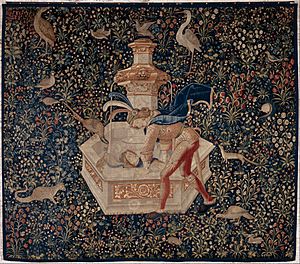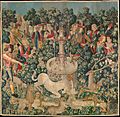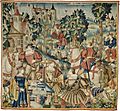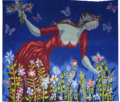Tapestry facts for kids
A tapestry is a special kind of art made from threads. It's created by hand on a tall, upright machine called a loom. Think of it like painting with yarn! In tapestry, the threads that go up and down (called the warp threads) are completely hidden. This is different from regular cloth, where you can see both the up-and-down and side-to-side threads.
Because the warp threads are hidden, the tapestry weaver can create a beautiful, colorful picture or pattern. Usually, the warp threads are made from strong materials like linen or cotton. The threads that you see, called the weft threads, are often made of soft wool or cotton. Sometimes, they even use fancy materials like silk, gold, or silver threads to make the tapestry shine!
Both talented craftsmen and creative artists work together to make tapestries. Artists draw the designs, sometimes on large pieces of cardboard called 'tapestry cartoons'. Then, skilled craftsmen carefully weave these designs into the amazing tapestries we see.
Contents
Why Were Tapestries Important?
Tapestries were very popular for many reasons, especially because they could be moved easily. A famous architect once called them "traveling wall paintings."
Tapestries for Decoration and Warmth
Kings and noblemen loved tapestries because they could roll them up and take them from one castle to another. This meant they could always have beautiful art with them. Churches also used tapestries for special events and celebrations.
During cold winters, tapestries were hung on the stone walls of castles. This helped to keep the rooms warmer by adding an extra layer of insulation. Of course, they also made the castles look much more grand and decorative!
The Bayeux Tapestry: A Special Case
You might have heard of the famous Bayeux Tapestry. It tells the story of the Battle of Hastings in 1066. However, it's actually not a true tapestry! It's a long piece of embroidered cloth, meaning the pictures were sewn onto the fabric rather than woven into it. It was probably designed and made in England by Anglo-Saxon artists.
Amazing Tapestry Pictures
-
Henry VIII is seated beneath a tapestry cloth of state
-
One of the tapestries in the series The Hunt of the Unicorn: The Unicorn is Found, circa 1495–1505, The Cloisters, Metropolitan Museum of Art, New York City
-
Tapestry Room from Croome Court, moved to the Metropolitan Museum of Art, hung with made to measure 18th-century Gobelins tapestries, also covering the chairs. 1763-71
-
The Triumph of Fame, probably Brussels, 1500s
-
A scene from the Bayeux Tapestry depicting Odo, Bishop of Bayeux, rallying Duke William's troops during the Battle of Hastings in 1066
-
Flemish 16th Century, The Return from the Hunt, c. 1525–1550, National Gallery of Art
-
Fall of Tangier, one of the Pastrana Tapestries (1470s), recording the victories of Afonso V of Portugal about a decade earlier. Woven in Tournai
-
Battle of Zama (202 BC), from a set of the life of Scipio Africanus, Gobelins copy of c. 1688, after designs by Giulio Romano and Francesco Penni for a set destroyed in French Revolution
-
Francisco Goya cartoon The Parasol, 1777, Prado
-
Constantine's Triumphal Entry into Rome, from The History of Constantine, designed by Peter Paul Rubens and Pietro da Cortona, 1622
See also
 In Spanish: Tapiz para niños
In Spanish: Tapiz para niños

















